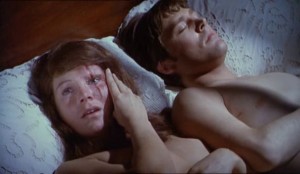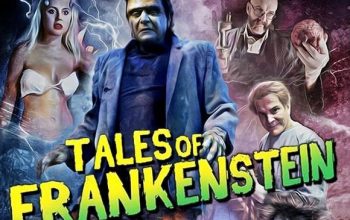Frankenstein Created Woman – 1967
‘It may appear strange that such should arise in the eighteenth century; but while I followed the routine of education in the schools of Geneva, I was, to a great degree, self-taught with regard to my favourite studies.’ — Mary Shelley, Frankenstein.
‘To the best of my knowledge, doctorates are not awarded for witchcraft. But if ever they are, no doubt I will qualify.’ — Baron Frankenstein, Frankenstein Created Woman.
We open on one of the Hammer Frankenstein series’ most enduring symbols – the guillotine. A prisoner is being lead to his death, drunken and defiant. He seems fearless and utterly unashamed of whatever act has lead him here – until he sees that his young son Hans is watching. He dies, quiet and glum.
Years later Hans (Robert Morris), now grown up, passes the guillotine on his way to his work. He is assisting the kindly, Gepeto-like Dr Hertz (Thorley Walters) with an experiment. Hertz’ partner Baron Frankenstein (Peter Cushing) has frozen himself to see if he can be revived. He’s duly thawed and shocked back into life.
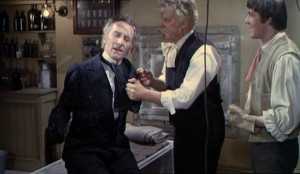
This is what he’s up to, now. Finding ways of improving surgical survival rates. The Baron’s work has taken a somewhat mystical tern. He’s concerned with keeping the soul – keeping it in the body, it seems.
Hans is sent off to buy some champagne to celebrate, and at the café he meets his girlfriend, Christina (Susan Denberg). Christina’s father looks down on Hans as the son of a convicted felon. Three rich, arrogant young men of the village (Peter Blythe, Barry Warren and Derek Fowlds) arrive and make Christina serve them wine so that they can mock her for her facial deformity and limp. It’s an uncomfortable scene. The landlord, fearful of his customers’ powerful families, is forced to allow this cruelty to his daughter to occur. When the abuse turns physical, Hans leaps to her defense.
Later, Hans meets secretly meets with Christina. They discuss their backstories, before ending up in bed. Downstairs the rich kids leave, the landlord complaining that they never pay. They pause to throw drunken insults at Christina’s window. They wait until the landlord leaves, then break into the café to steal some booze. When the landlord returns unexpectedly, they set upon him and beat him to death.
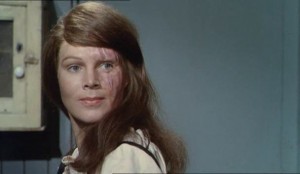
Meanwhile Frankenstein and Hertz are at work. Frankenstein has learned to extract energy from rock and use that energy to make an impenetrable force field. The Baron explains that his plan is to conquer death by containing the soul in a force field, holding it there while he repairs the damage to the body. This is a) more benevolent than many of the Baron’s experiments and b) demented.
While Christina is out of town, the murder is discovered. Between his father’s history and some circumstantial evidence, Hans is suspected — but he can’t bring out his alibi without destroying Christina’s reputation. Even with Baron Frankenstein as a character witness, he is convicted.
Frankenstein decides to preserve Hans by transferring his soul using the force field. Hans is guillotined, just as Christina returns to town. She sees the execution. Horror-struck, she throws herself off a bridge and drowns.
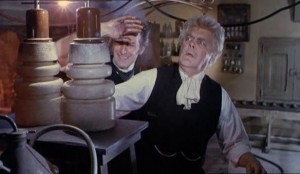
Hans’ soul is duly taken by the Baron and — irony of ironies! — placed into the body of Christina. Frankenstein heals Christina’s face and leg and brings her to life. The strange thing, though, is that she doesn’t seem to be Christina or Hans. Though given the name ‘Christina’, she seems to be a wholly new person, growing under the tutelage of her distant father, Baron Frankenstein and the more kindly and affectionate Dr Hertz.
She has no memories of her own life, but when shown the guillotine she remembers the death of Hans’ father. That night, she awakes, goes into town and lures one of the rich boys to his death. The next night, same deal, but the dead boy writes ‘HANS’ in his own blood before he dies.
An angry—but surprisingly polite—mob approaches Frankenstein, blaming him for Hans’ return and threatening to burn the Baron for witchcraft. To prove his innocence, Frankenstein has Hans’ body disinterred. The body is there, but the head is missing. It is in Christina’s room, giving orders to her.
The Baron figures out what is going on, but is placed under house arrest before he can stop Christina. The last murderer escapes from town, but Christina is waiting for him on the stagecoach. Frankenstein desperately tries to talk his way past the cops. When they threaten to destroy Christina, he escapes and rides off to the rescue. He’s spry for his age, I tell you.

The stagecoach breaks down, and Christina lures her last victim into the forest and stabs him to death. Hans, speaking through her, says that her work is done and she can rest now. Frankenstein arrives, shocking Christina back to herself. Horrified at what she has done, she runs off to a cliff. Frankenstein follows and attempts to convince her not to jump by offering to tell her who she is. She says she knows, apologises, and jumps.
I’m strongly of the opinion that Frankenstein Created Woman is the best of the Terrence Fisher/Peter Cushing Hammer Frankensteins. I’ve said before that what makes the Hammer Frankensteins interesting is the way they mix the Frankenstein story with other horror tropes to add some variety. Revenge is essentially a vampire movie, Evil is Dr Caligari and Created Woman is a ghost story.
What I mean by that is that it’s the story of a haunting. Three murderers are stalked by the ghost of their victim, who kills them one by one. It’s been done many times — only this time instead of being a haunted house it’s a haunted person that is the instrument of the ghost’s vengeance.
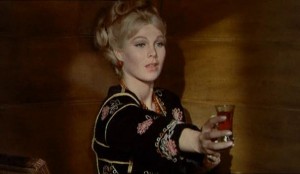
The question is, when Hans’ soul isn’t running Christina’s body who is? Is she soulless? She doesn’t appear to be. And yet she doesn’t seem to have Christina’s soul, since it is implied that memories are embedding in souls and she retains no memories of Christina’s life. There also seems to be a third state in between ‘Hans in charge’ and ‘Christina in charge’ where Christina seems to be talking, trancelike to Hans. It’s baffling — without being random or senseless.
My theory is that whereas many Frankenstein movies conflate the terms ‘brain’ and ‘identity’, this one conflates ‘identity’ and ‘soul’. The revenant Christina lacks an identity. Dr Hertz hamfistedly attempts to give her dead Christina’s identity, but Frankensteins’ orders prevent him from telling all. Not knowing who she is, Hans is free to tell her who she is, crafting her into the instrument of his vengeance. Frankenstein realises, too late, that the way to defeat Hans is to finally let Christina know who she is and thus restore her identity. But by then it’s too late.
Having said that, there are certainly other ways to read this element of the film. It’s genuinely thought-provoking, and a much better meditation on subject of monsters and souls than, say, I, Frankenstein.
The characterisation of Peter Cushing’s Frankenstein is wildly inconsistent across the Hammer series. He’s genuinely evil in Curse and Revenge, misguided but basically benevolent in Evil, before going back to his pure evil roots in Frankenstein Must be Destroyed. In Created Woman, he’s shown to be mostly amoral. He has science to do, and won’t let considerations of right and wrong stand in his way. By the same token, he doesn’t go out of his way to hurt anyone as he does when he’s in pure evil mode.

‘Oooh, sounds kinky…”
Cushing’s performance reflects this scripting choice. He plays the Baron as determined and somewhat emotionless. He is continually pushing the weak willed Hertz to do his bidding, but isn’t unnecessarily cruel to the man. He is loyal to his employee and his creation, testifying in Hans’ favour and risking himself to save Christina. There’s a line during an experiment where he tells Dr Hertz to be careful, and it sounds like he’s actually concerned for his friend’s safety. He’s Frankenstein at his most complex–in the Hammer Frankenstein movie that is the least to do with him, and the most to do with his creation.
The relationship between Frankenstein and Hertz is interesting. There’s a gay subtext there – the cliché of the dominant and subservient partner in their same-sex parenting arrangement. Certainly, Thorley Walters plays up this angle a little, which is a good thing. He often has to show physical affection to Christina, and his slightly camp performance prevents this from looking creepy or inappropriate.
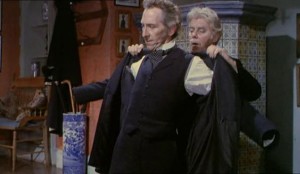
Susan Denberg who plays Christina isn’t the best actor ever, but she’s not the worst either. She does a pretty good job playing what is in effect the triple role of Alive Christina, Revenant Christina and Hans’ ghost. I think she puts her best effort into Alive Christina, giving us a character who is beaten down, and yet also hopeful.
Then there’s the issue of Christina’s sexuality. When she’s alive, she’s portrayed as being deeply ashamed of her appearance and yet when she’s alone with Hans she seems perfectly confident in her sexuality. It’s a beautifully ironic scene when the rich boys are singing outside her window, taunting her for being so ugly that she must die a virgin, while she’s inside with her lover.
Revenant Christina, on the other hand, has a sort of childish, sexless quality to her. But when she’s being possessed by Hans she’s a shameless seductress. It’s tempting to criticise the film for portraying female sexuality as something scary that leads men to their doom, and yet on the other hand it’s a male character who is actively reshaping Christina into a femme fatale. The fact that this sort of character is, ultimately, a male fantasy is addressed in the movie before the critic even gets to it.
It’s interesting that in both the Universal and Hammer Frankenstein series, the ‘let’s make the Monster a woman’ episode is the most interesting. Partly I guess it’s because it forces the writers to look past the ‘and then the Monster arises, knocks stuff over, and dies’ cliché, but partly it’s because there is a huge gap in Mary Shelley’s novel, and that gap is in the shape of the female monster that Victor Frankenstein refuses to complete. Mary Shelley told us what Frankenstein’s Monster was like, but baulked at telling us what his female counterpart would be.
This pretty clearly comes down to sex, or more specifically reproduction. Frankenstein is a story about a man (or men) effectively reproducing without the assistance of a woman. Adding the female monster changes that dynamic tremendously. Mary Shelley’s novel was tremendously daring for its time, but she refuses to go that far.
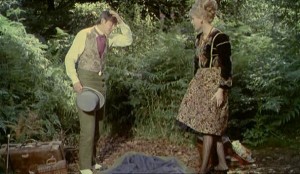
Both Bride of Frankenstein and Frankenstein Created Woman try to fill the gap Mary Shelley’s decision leaves. They play out different ways, but ultimately end with Frankenstein alive and well and his female creation destroyed. While the Monster often comes back from the dead, the Bride never seems to. The Karloff Monster comes back in Son of Frankenstein leaving Elsa Lanchester in the ground, while the Cushing Frankenstein never builds another woman after Christine.
I sort of wish I knew why. On the other hand, I suspect I’d find the answer depressing.

